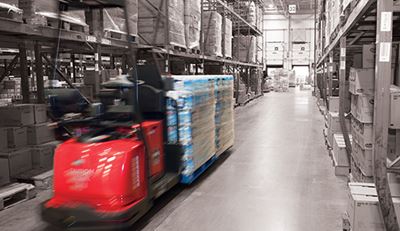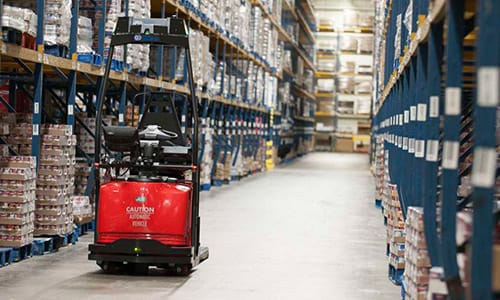Facility and fleet optimization for maximum efficiency and productivity

With changing material handling demands, automation has become a necessity for the industry. As labor pressures increase and as technology becomes more affordable and applicable, plant facilities are recognizing the added value that semi- and fully automated vehicles can offer to increase plant productivity.
In today’s fast-paced e-commerce world, every inch of empty or unused warehouse space means lost revenue. As e-commerce demands continue to push the material handling industry for faster timelines and more product, there are ways plant managers can optimize their facilities to make sure every truck, every person, and every inch of space is working hard for the company.
Optimum space use for maximum efficiency
Optimizing warehouse space allows plant managers to fit more product on the floor and ship items more quickly, helping meet e-commerce needs and bringing more revenue back to the plant. It’s a win for everyone.
When evaluating how to optimize warehouse space, it’s helpful to determine which equipment is being used for each job and assess whether it is the most effective truck for the project. For example, when visiting a customer’s site to discuss equipment options, I noticed the facility had double-racking 12-foot-wide aisles and was using sit-down counterbalanced trucks. By simply reducing the aisle size to 9 feet and using a reach truck that was better suited for narrow aisles, the customer had enough space for 126 additional pallet positions. This approach increased operational efficiency and warehouse productivity.
Investing in automation for increased productivity
With changing material handling demands, automation has become a necessity in our industry. Automated systems are growing in popularity not only to increase warehouse efficiency but also to address labor shortages. As labor pressures increase and as technology becomes more affordable and applicable, plant facilities are recognizing the added value that semi- and fully automated vehicles can offer to increase plant productivity.
When plant managers decide to invest in automation, it’s important to find a partner that can provide automated offerings to serve different warehouse needs and functions. Here are a few market options to consider:
- Automated guided vehicles (AGV): These fully automated self-driving vehicles can increase efficiency and accuracy. The trucks are ideal for repetitive and time-consuming tasks, so plant managers can reallocate their operators’ time to more value-added jobs.
- Vertical and horizontal carousels: These automated carousels provide high-productivity solutions for storage and retrieval. The systems offer significant gains in efficiency, control of inventory management, and warehouse floor space recovery.
- Vertical lift modules: These popular tools use a highly flexible automated system to help maximize cube utilization and organize picking, replenishment, and cycle counting. The modules can greatly increase order-picking throughput and help minimize picking errors.
- Deep lane automated system: This type of system is designed to handle many pallets in lanes of 10 to 100 pallets deep using robots for pallet transportation from induction to discharge.
- Pick modules: These multilevel storage systems integrate with picking systems, conveyors, and sortation to maximize storage capacity and increase throughput.
The steadily increasing pressures of e-commerce demands and a growing labor shortage make optimizing space and labor efficiency imperative for companies to keep their doors open and stay competitive. Time and space are money, and with facility and fleet utilization tools, plant managers can help ensure their assets are working optimally for them.
Submitted by Chris Burton (Abel Womack) on Mon, 04/02/2018 - 13:16
Plant Services, Today's Optimized Facility
Read the original post: https://www.plantservices.com/blogs/todays-optimized-facility/virtual-reality-engaging-new-generations-and-increasing-operator-proficiency/


